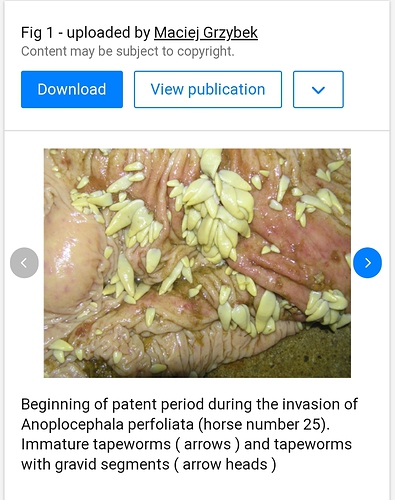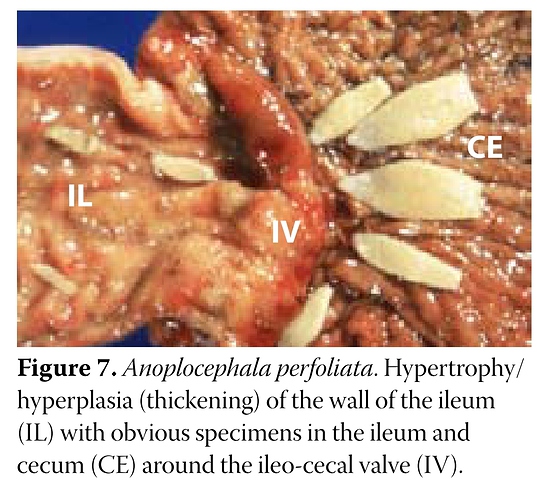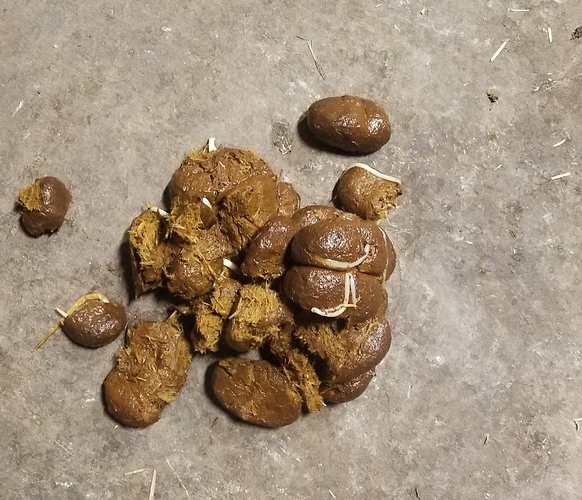For EGGS, JB. Tape worm SEGMENTS are visible to the naked eye, and resemble sesame seeds. The post from the vet clinic presumably called them “eggs” inaccurately because that’s the easiest way to get the point across to their clients. But the picture is SEGMENTS.
Here are pics of tape worm in horse manure, yick:
Doesn’t matter.
A. perfoliata segments are still bigger than sesame seeds. They’re as wide as the tapeworm adult, which is in the range of 8-14mm, and much less long, as in, they’re more more of rectangle than a square in L x W dimensions.
A. magna, less common in horses, is even bigger.
Sesame seeds are 3-4mm x 2mm or so.
Chico Animal Hospital is a small animal clinic. Not horses.
Dude, I think it’s pretty clear from the pics that tapes in horse poop could indeed be described as looking like sesame seeds, especially if they’re immature, but this is a very weird hill to die on, so if you want to commit to that, go right ahead.
You might need to use Quest to target encysted strongyles.
Moxidectin (in Quest) will kill them (mostly) while ivermectin (in Equimax) will not.
That was my point.  That we do need to check effectiveness of dewormers when dealing with heavy loads.
That we do need to check effectiveness of dewormers when dealing with heavy loads.
The eggs themselves are small, yes, but the proglottids are not. There are tapeworms that release proglottids that then release eggs (ex the rice grain bits you find in cat bedding) and tapeworms that release eggs in feces and then the proglottid is released. Horses are the latter. If you see tapeworms in horse poo, it’s likely the entire organism.
Horse tapeworms are often quite small- much smaller than dog or cat tapeworms. Tapeworm size doesn’t correlate to host size.
There is no documented anthelmintic resistance in large strongyles, so any drug you use should work. You also wouldn’t confuse ascarids for strongyles. The former is about pencil size and cream colored, the latter much smaller.
If you were seeing a bunch of small red worms, those are likely one of the larger small strongyle species.
No drug works for both ascarids and small strongyles. A FEC would be very useful for determining which drug would actually work.
If they were small ish and white with a long thin tail, those are pinworms and would be diagnosed with a tape test. They are frequently resistant to ivermectin.
Get a fecal, take a pic of the worms, and talk to your vet.
A poop picture. Not the worst of it by far.
We did Quest plus last year, but she was on outside board, so I don’t know if I would have seen the worms that came out.
Curious about the tapeworm eggs as being a possibility. I wish I had taken a picture, but they did not look like segments. They were not flat or white - I guess more like roasted sesame seeds vs raw. The odd thing was, with my mare, it was only one day, that her poop was full of the “seeds”. The hay is just a mixed grass. Could be some slew grass mixed in. Maybe someone gave them some different treats?
It is very winter here, My understanding is that it is too cold for the eggs to survive to infect another horse in this weather?
It took me a long time to realize that was a paperclip and not a coiled rope! Those eggs are definitely too small for me to have noticed at a glance.
Those look like ascarids, but it’s hard to tell without seeing the whole worm or having something for scale.
If they are ascarids, macrocyclic lactones (ivermectin, moxidectin) will most likely be ineffective. It’s pretty uncommon for adult horses to have them in high burdens, but if the horse came from a neglect situation not impossible.
Ascarid eggs are very hardy and can survive on pasture for years. They will only larvate and become infective when conditions are right, but the cold will not get rid of the eggs.
Those definitely are not tapeworms.
They don’t look like sesame seeds in horse feces and it’s pretty uncommon to see tapeworm bits in feces, even in horses with high burdens. Heck I’ve seen horses at necropsy loaded with tapeworms and they were never positive on a fecal! Tapeworm proglottids in horses don’t shed into the seed/rice grain bits that are seen in other animals.
The horse is an older teen. I don’t know that she was ever neglected, but the barn she came from is known for being over crowded and having de-wormer resistance - part of the reason they moved. I don’t know much about where she came from previously, but given her training/experience, she was likely in a decent program.
I’d get a fecal and tape test done and go from there. Older horses can also get ascarids, but unless she came from a place with foals it would be a little odd for her to have been exposed. If you’ve noticed any white discharge around her anus, then it’s likely pinworms. Absence of that doesn’t necessarily rule them out though.
Those could either be ascarids or big fat pinworms. Definitely not strongyles or tapeworms!
If you’re lucky enough to get an actual worm there’s no need to do a tape test. The needle thin tail is definitive for pinworms. Best time to find pinworms in feces is from manure deposited in the evening, because this is when the worms are active. Also a yellowish or cream colored discharge around the anus is typical of pinworms.
The worms in the photo look more like ascarids (roundworms) because they don’t seem to have the typical pinworm tail.
Proglottids, when they are dried up can be rehydrated in water.
Bottom line is you and the pasture mates need to get together with vets for a solid diagnosis and program based on the new concepts of management
Resistance to wormers is a world-wide problem, partly because to old “good regime” actually caused resistance to build up. There are no new meds available. (Think about that.) You need to get the vet involved and work on a barn-wide programme based on feacal egg counts and blood tests. There are other steps that can be taken to help reduce the worm burden such as very regular poo-picking, resting pastures, reducing the number of animals per acre and grazing with sheep or cattle. All of which might be not be do-able in a cramped commercial barn setting - except the very regular poo-picking in any turnout.
I’m suggesting to do a tape test because you can’t tell from the photo if they are ascarids or large pinworms. The tails aren’t visible. I agree that they look more like ascarids but as I am not there to physically look at them, it’s best to consult a veterinarian and do proper diagnostics.
Plenty of people find pinworms in feces at various times of day when burdens are high. It’s just best to get diagnostics (a fecal egg count and tape test) done by a vet (or take them some worms) because most people aren’t diagnostic parasitologists. I have a PhD and not a DVM and so I always recommend proper testing with a veterinarian.
These are much larger than pin worms. Like linguini.
I plan to do a fecal egg count in the spring as we usually do (admittedly I skipped last year), but this horse’s owner has been trying to address her worm load for three years with no success (with vet advice, but not the vet I use), so I am looking for other ideas.
Cleaning paddocks daily is not a service we offer, and very difficult in the winter. We scrape/harrow when it is warm/dry.
If pastures aren’t being picked then it’s going to be challenging for this particular horse who is susceptible to ascarids. The eggs remain viable in the soil for years.
I’ve heard these stories before where people are unable to get ascarid infections under control. Often times they’ve been using macrocyclic lactones, which are ineffective. Keeping the horse in an area where feces can be picked should be pretty effective at preventing reinfection, but doesn’t address current worm burden. It might be worth getting blood work done to make sure the horse doesn’t have any immune deficiencies that would make it more susceptible.
Martin might have more suggestions, you can always Google him and send him and email. Just search for Dr. Martin Nielsen at Gluck Equine Research Center. He’s also active on Horse Vet Corner on Facebook if you want to post there.
Edit:
Ascarids
Choosing Dewormers



